Standard [CURRENT]
ASTM E 3219:2025
Standard Guide for Derivation of Health-Based Exposure Limits (HBELs)
- Publication date
- 2025
- Original language
- English
- Pages
- 33
- Publication date
- 2025
- Original language
- English
- Pages
- 33
- DOI
- https://dx.doi.org/10.1520/E3219-25
Product information on this site:
Quick delivery via download or delivery service
Buy securely with a credit card or pay upon receipt of invoice
All transactions are encrypted
Short description
1.1 This guide describes the scientific procedures underlying the integrative interpretation of all data concerning an active pharmaceutical ingredient (API) taking into account study adequacy, relevance, reliability, validity, and compound-specific characteristics (for example, potency, toxicological profile, and pharmacokinetics) leading to a numerical value for the API, which is used further in the quality risk management (ICH Q9) of cross contamination during the manufacture of different products in the same manufacturing facilities. 1.2 This guide describes general guidance for calculating and documenting a health-based exposure limit (HBEL). It should serve the involved qualified experts as a reference for HBEL derivations and should harmonize the different approaches and nomenclature to the greatest extent possible. 1.3 This guide should be used for calculating and documenting an HBEL, when required or necessary, for APIs (including biologics), intermediates, cleaning agents, excipients, and other chemicals (that is, reagents, manufacturing residues, and so forth) used for cleaning validation and verification (Guides F3127 and E3106 ). In scope is the cleaning and cross contamination of surfaces of manufacturing equipment and medical devices but does not include leachables/extractables (21 CFR 211.67, 21 CFR 610.11, 21 CFR 820.70, and 21 CFR 111.27). The forthcoming ICH Q3E guideline will address leachables/extractables from manufacturing equipment. 1.4 The principles in this guide may also be used as a basis for setting occupational exposure limits. 1.5 The principles in this guide may be applied during the development and commercial manufacturing of small or large molecular weight medicines as well as isolated pharmaceutical intermediates. 1.6 Subsequent-product HBEL values may be set for specific routes of exposure (for example, oral, inhalation, and parenteral) when necessary (for example, because of differences in bioavailability) and for specific patient populations (for example, children) if formulations are manufactured in which one daily dose is not for the 50 kg standard adult but the dosage form is adjusted to a target population with a lower body weight. 1.7 The primary scope of this guide is to ensure the safety of human patients exposed to residual active substances and intermediates via medicinal products. The general principles of this guide can also be applied to the manufacture of veterinary medicinal products. However, there may be certain unique toxicological and pharmacological species-specific differences, such as metabolism and sensitivity, as well as assumptions such as body weight for veterinary medicines that are not addressed in this guide. 1.8 This guide may be used independently or in conjunction with other proposed E55 standards published by ASTM International. 1.9 Units- The values stated in SI units are to be regarded as standard. No other units of measurement are included in this standard. 1.10 This standard does not purport to address all of the safety concerns, if any, associated with its use. It is the responsibility of the user of this standard to establish appropriate safety, health, and environmental practices and determine the applicability of regulatory limitations prior to use. 1.11 This international standard was developed in accordance with internationally recognized principles on standardization established in the Decision on Principles for the Development of International Standards, Guides and Recommendations issued by the World Trade Organization Technical Barriers to Trade (TBT) Committee.
ICS
11.120.10
DOI
https://dx.doi.org/10.1520/E3219-25
Also available in
Loading recommended items...
Loading recommended items...
Loading recommended items...
Loading recommended items...

